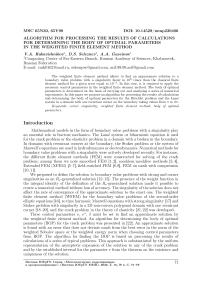Algorithm for processing the results of calculations for determining the body of optimal parameters in the weighted finite element method
Автор: Rukavishnikov V.A., Seleznev D.S., Guseinov A.A.
Рубрика: Программирование
Статья в выпуске: 4 т.15, 2022 года.
Бесплатный доступ
The weighted finite element method allows to find an approximate solution to a boundary value problem with a singularity faster in 106 times than the classical finite element method for a given error equal to 10-3. In this case, it is required to apply the necessary control parameters in the weighted finite element method. The body of optimal parameters is determined on the basis of carrying out and analysing a series of numerical experiments. In this paper we propose an algorithm for processing the results of calculations and determining the body of optimal parameters for the Dirichlet problem and the Lamé system in a domain with one reentrant corner on the boundary taking values from π to 2π.
Corner singularity, weighted finite element method, body of optimal parameters
Короткий адрес: https://sciup.org/147240331
IDR: 147240331 | УДК: 519.63 | DOI: 10.14529/mmp220406
Текст научной статьи Algorithm for processing the results of calculations for determining the body of optimal parameters in the weighted finite element method
Mathematical models in the form of boundary value problems with a singularity play an essential role in fracture mechanics. The Lam´e system or biharmonic equation is used for the crack problem or the elasticity problem in a domain with a broken in the boundary. In domains with reentrant corners at the boundary, the Stokes problem or the system of Maxwell’s equations are used in hydrodynamics or electrodynamics. Numerical methods for boundary value problems with a singularity were actively developed recently. For instance, the different finite element methods (FEM) were constructed for solving of the crack problem; among them we note smoothed FEM [1, 2], meshless/meshfree methods [3, 4], Extended FEM (XFEM) [5–7], field-enriched FEM [8, 9], FEM on mesh with compression [10,11].
We proposed to define the solution to boundary value problems with strong and corner singularities as an R ν -generalized solution [12–15]. The presence of the weight function in the integral identity of the definition of the R ν -generalized solution made it possible to create a numerical method without loss of accuracy. The singularity of the solution does not affect the rate of convergence of the approximate solution to the exact one. The weighted finite element method (WFEM) for the boundary value problems of the second-order elliptic equations [16], to time harmonic Maxwell equations with strong singularity [17] and Stokes problem with singularity in a 2D non-convex polygonal domain with one reentrant corner [18–20], and the crack problem in the theory of elasticity [21, 22] was developed.
Three control parameters ν, ν ∗ , δ must be set to find an approximate solution by the weighted finite element method. An algorithm for determining the body of optimal parameters (BOP) for the crack problem was presented in [22]. An approximate solution is found with an error that does not deviate much from the best error in the norm of the weighted Sobolev space or the weighted energy norm when choosing control parameters from BOP. The algorithm for finding the BOP is based on processing the results of calculations of a series of typical problems. This approach is substantiated by the uniform representation of the asymptotic expansion of the solution to any of the crack problem and by the established interval for the parameter ν from the theorem on the existence and uniqueness of the solution.
In this paper, we present an algorithm for processing the results of calculations and determining the BOP for the Lam´e system in a domain with a reentrant corner from π to 2n at the boundary.
1. Rν -Generalized Solution and Weighted Finite Element Method
We consider a boundary value problem for the Lam´e system with constant coefficients A and ц with respect to the displacement field u = (u 1 ,u 2 ):
- (2 div(^e(u)) + v (A div u)) = f, x G Q, (1)
u = q , x G dQ. (2)
Here e(u) is the strain tensor, f is a distributed body force, Q is a bounded non-convex polygonal domain with the boundary dQ containing one reentrant corner such that its vertex is located in the origin O(0,0).
Let Q ‘ = { x G Q : (x 2 + x 2 ) 1/2 < 5 ^ 1 } be the ^-neighborhood of the point O(0,0) in Q. We introduce a weight function p(x) that coincides in Q with the distance to the origin, i.e. p(x) = (x 1 + x 2 ) 1/2 for x G Q ‘ , and equals to 5 for x G Q \ Q ‘ .
Denote by W 21 a (Q,5) the set of functions satisfying the following conditions:
-
a) | D m u(x) | < c 1 (5 \ p(x)) a+m for x G Q , where m = 0,1, the constants c 1 > 1 is independent of m;
-
b) ||u(x) ||L 2 a (Q \ Q') > c 2 , where c 2 = const; with the squared norm
Н^ад = E p(x) | D m u(x) iH L 2 (Q) ,
| m |< 1
where m = (m 1 ,m 2 ) and | m | = m 1 + m 2 , and a is a real nonnegative number.
We use the notation W 2 a (Q, 5) for the corresponding set of vector functions.
Define R ν -generalized solution to problem (1), (2) as a function u ν from the set W 2 a (Q, 5) that satisfies the boundary value conditions on dQ and satisfies the following integral identity:
a(u v , v) = l(v) for all v = (v 1 ; v 2 ) G W 1, v (Q,5).
Here a(u, v) = J (2^(u)) : e(p 2v v) + A div u div (p 2v v))dx, l(v) = J p2 f • vdx. Q Q
The weighted finite element method for finding an approximate R ν -generalized solution to problem (1), (2) was constructed in [23]. Here we briefly describe construction of the WFEM.
We perform a quasi-uniform triangulation of the domain Q. Let K be the union of all the triangles K i , i = 1,... ,n; h be the maximal length of the sides of the triangles. We refer to h as a mesh step. The vertices P i , i = 1,..., M of the triangles K are nodes of the triangulation, {P M } = {P 1 ,..., P M } and the point O G P M . Let P = {P k } k=N be the set of internal triangulation nodes.
To each node P i G P we assign the weighted function
^i = pv*(x)^i, i = 1,... ,N, where ϕi is a linear function on each triangle K equal to 1 at the node Pi and zero at all the other nodes, ν∗ is a real number.
We introduce the weighted vector basis { ^ k (x) } k=1N , where
^ k (x) = |
(^i(x), 0),k = 2i - 1, (0,^i (x)),k = 2i, i = 1,...,N.
Denote by V h the linear span { ^ k (x) } k =1N . In V h we consider the subset V h = { v G V h : v(P i ) = 0,P i G dQ } .
In the space V h , a function u h is called an approximate R v -generalized solution of problem (1), (2) by the weighted finite element method if u h satisfies boundary value condition (2) for the mesh nodes P i G dQ and the integral identity
a(u h , v h ) = l( v h ) holds for all v h G V h .
An approximate solution is found in the form
2N
Uh = ^dk ^k (x)’ k=1
where d k = p - v * (P [(k+i)/2] )c k , C k = ( U iH P !^ 1 )/ 2 ] ]’ k _ 2i 1 , i = 1,. . . , N, [(k + 1)/2]
I Uv,2(P[(k+1)/2]),k = 2i is integer part of the number (k + 1)/2.
In contrast to the classical FEM, the weighted finite element method allows to find a solution to problem (1), (2) with an accuracy of O(h).
2. Algorithm for Determining Body of Optimal Parameters
We need to set the parameters ν, ν ∗ , δ to calculate the approximate R ν -generalized solution to boundary value problem (1), (2) by the weighted finite element method with the smallest error. There exist no theoretical methods for determining the optimal parameters v, v * , 5, so we determine these parameters experimentally for different corners w (п C w C 2п). We use data on the permissible intervals of the parameters v and v * . The admissible values of the parameter ν are in the half-interval, which is established in the existence and uniqueness theorem of the R ν -generalized solution [13]. The values of the parameter v * are determined from the interval [0, 0,49] based on the asymptotic of the solution to problem (1), (2) [24].
The algorithm for determining the BOP is given in [22]. We consider two model problems (1), (2) in the domains Q (i) with reentrant corners w i = п + n (i — 1),i = 1,..., 7 (see Fig. 1).
Problem (A i )
K i 1 .п /6\ Г A . 2 /6А]
u 1 = 7?Г "i cosW P — • ■ + sln ШJ’
Kt 1 /е\ r a „ /»\i u2 = 7TSr"i ВШЫ [2 — A7^ — cos Ы ]'
Lame coefficients are A = 576, 923,7 = 384, 615, and the stress intensity factor is K I = 1, 611.
Problem (B i )
u 1 =
K i 1 n.
--■= r “ cos
^ y2n
(d1
-
λ
A + p
+ sin 2 (0] + r 2 ,
K I 1 n_ (e
= T Ж “i sin (2) [2
λ
A + ^
2 ©I
The solution to problem (A i ), i = 1,..., 7 is singular. The solution to problem (B i ), i = 1,..., 7 contains singular and regular components.
In Q(i) ,i = 1,..., 7, we construct the quasiuniform meshes Hj (j = 1,..., 6) with the step h = 0, 062, 0, 031, 0, 015, 0, 0077,0, 0038, 0, 0019. For each problem (Ai), (Bi) and each mesh Hj we determine three parameters ν, ν∗ , δ for which the relative error in the weighted Sobolev norm is the smallest. We form the sets (Аг,Н3) НАК) АЛК) (HBiK) НАК) of parameters T^ , T2 , T3 , T1 , T2 ,
TН) and Tij = T(AHj) Q TВН),k = 1, 2, 3, at which 3 k k k the relative errors differed from the best error by no more than 5% (6.5%), 10% and 15%. For each mesh Hj the body of optimal parameters is Tj = Qi=1 T^j, k = 1, 2, 3.
+ r 2 , i = 1,..., 7.
lx2 1
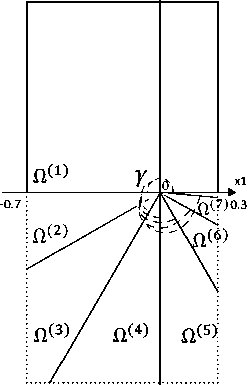
-1
Fig. 1. Domains Q(i), i = 1,..., 7
3. Algorithm for Processing Calculation Results. BOP Visualization
An approximate solution to problem (1), (2) for given initial data (coefficients, righthand sides of the equation and boundary value conditions, parameters h, ν, ν ∗ , δ) was found using the program “Proba-IV” [25]. An algorithm and a computer program for processing the results of calculations of a large series of problems and determining the BOP were developed. The created program allows:
-
• to define the sets T^ j = T ( A,H j ) Q T ( Bl,H j ) , k = 1, 2, 3, for the fixed mesh Hj- (j = 1,..., 6) and the domain Q (i) , i = 1,..., 7;
-
• to determine the BOP T j = Q i=1 T^j , k = 1, 2, 3, for each mesh H j (j = 1,..., 6) and the set of domains Q (i) , i = 1,..., 7;
-
• to visualize the sets T i,j and the BOP;
-
• to create tables with intervals of control parameters included in a BOP.
The calculation results of problems (A i ) or (B i ) on the mesh H j for fixed parameters δ , ν , ν ∗ were used as input data:
-
• an identifier of the calculated problem;
-
• a mesh step label;
-
• values of control parameters;
-
• values of the exact solution in norms of the spaces L 2 (Q), W^ v (Q), E v (Q) and in a seminorm W^ v (Q);
-
• values of the errors for an approximate solution in norms of the spaces L 2 (Q), W^v (Q), E v (Q) and in a seminorm W 21 v (Q);
-
• values of the relative errors for an approximate solution in norms of the spaces L 2 (Q), W 21v (Q), E v (Q) and in a seminorm W 1v (Q);
-
• values of the approximate solution in norms of the spaces L 2 (Q), W^ v (Q), E v (Q) and in a seminorm W 21 v (Q).
3.1555894824096118733702809e-02 0.030936 0.9 0.1
First, we form a text file from the input data containing the value of the norm of the relative error and the corresponding values of the parameters 5, v, v * . For example, when analyzing the error in the space norm W ^v (Q) the data sample has the following form:
Fig. 2 . Example of a sample data
Further, for all parameters 5, v, v * from the specified ranges, a row with the smallest norm of the relative error is selected and an array of rows is formed in ascending order of error. Out of the entire set of rows, we select three subsets T ( A i H ) , T ( A i H 3 ) , T A i H j ) or T B i H j ) , T ( B i ,H j ) , T ( B i H j ) at which the relative errors differed from the best error by no more than 5%, 10% and 15% (see, for example, Fig. 3). Then, the sets T ij = T (A i H 3 ) П T ( B i H3 ) , k = 1, 2, 3 are determined.
kk k
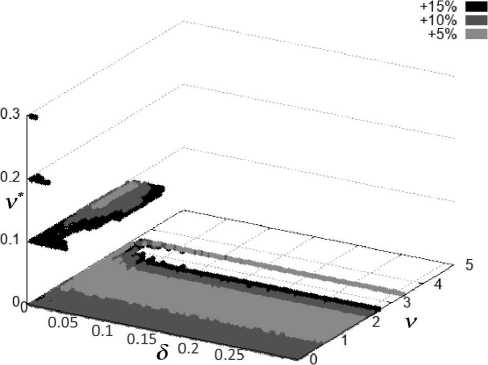
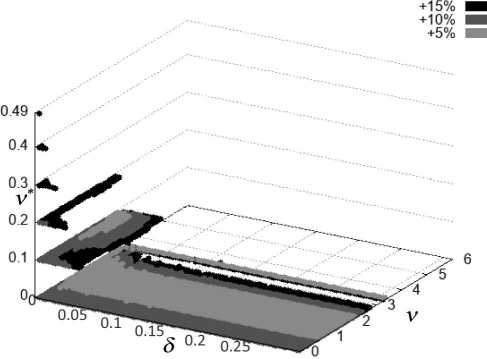
b)
+15% ■
+10% ■
+5% ■
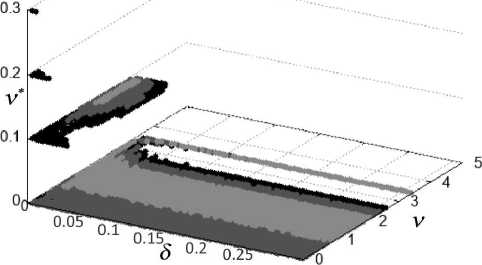
Fig. 3 . (3а) the sets T A) , T 2 ( A 5 ) , T 3 ( A 5 ) ; (3b) the sets T (B 5 , T 2 ( B 5 ) , T 3 ( B 5 ) ; (3c) the sets T j ,j = 1, 2, 3 for the mesh with a step h = 0, 0038
We say that the BOP is a set of parameters 5, v, v * which is simultaneously included in all T^ j in the domains Q (i) , i = 1,..., 7 for a fixed mesh H j (j = 1,..., 6), i.e. T j = n i=i T k'j , k = 1, 2, 3 (see, for example, Fig. 4).
At the next step, the program, by exhaustive search and comparison of the corresponding parameters, determines the BOP. In some cases, it is possible to determine the BOP not for all domains Q (i) , i = 1,..., 7 but for separate groups, for example, for problems in domains with reentrant corners {180 ° , 210 ° , 240 ° } or {270 ° , 300 ° , 330 ° , 360 ° }.
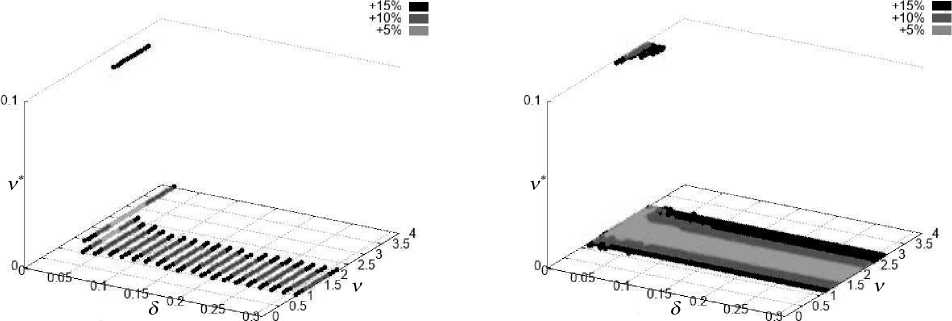
а) б)
Fig. 4 . The body of optimal parameters for the mesh with steps h = 0, 015 (4a) and h = 0, 0019 (4b) together for all domains Q (i) , i = 1,..., 7
In addition, we determine the BOP at which the deviation of the relative error from the best one does not exceed 5% and 6% (see, for example, Fig. 5). This indicates the sustainability of the process. The error changes insignificantly with a small deviation in the choice of parameters from the best parameters.
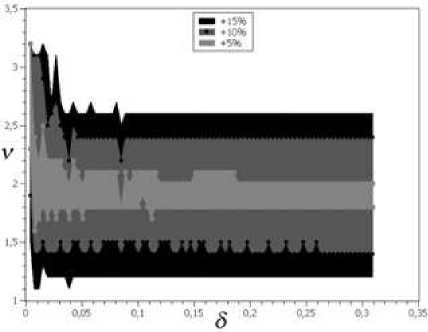
a)
Fig. 5 . Parameter values at which the deviation of the relative error from the best one does not exceed 5% and 6% for all domains Q (i) , i = 1,..., 7 on the mesh with a step h = 0, 0038
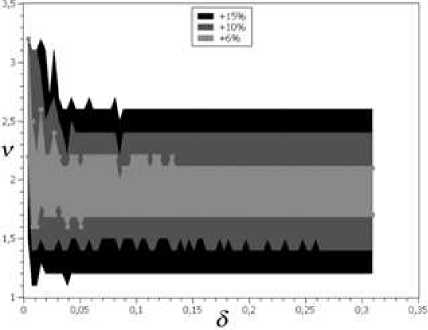
b)
Various sets of parameters and the BOP visualization was carried out using the “gnuplot” program [26]. The input text file contained the values of parameters 5, v , v * on each line. These parameters determined the coordinates of a point in three-dimensional space. The error ranges were indicated in the executive file for correct visualization.
-
• The parameter v * was sequentially assigned the values 0, 0, 0,1, 0, 2, 0, 3, 0,4, 0,49.
-
• For each value of v * and 5 = h, 2h, 3h, ... an interval of parameters was chosen for which the approximate solution error norm deviated from the minimum error by no more than a given limit value.
-
• For each value of v * intervals of 5 were determined with the same intervals of v.
As a result, the table was formed (see, for example, Table).
The choice of the optimal parameters for the weighted finite element method provides the creation of codes for finding an approximate solution with high accuracy for problems of elasticity theory with a corner singularity.
Table
Table sample
|
Percent of error |
δ |
ν |
ν ∗ |
|
5% |
1h-5h |
0,6...1,4 |
0 |
|
1h |
0,7...3,1 |
0,1 |
|
|
6.5% |
1h-5h |
0,5...1,5 |
0 |
|
1h |
0,5...3,3 |
0,1 |
|
|
10% |
1h-5h |
0,1...1,8 |
0 |
|
1h |
0...3,8 |
0,1 |
|
|
1h |
0,4...2,9 |
0,2 |
|
|
15% |
1h-5h |
0...2,9 |
0 |
|
1h |
0...4,3 |
0,1 |
|
|
1h |
0...3,9 |
0,2 |
Acknowledgments. The reported study was supported by the Russian Science
Foundation, project No. 21-11-00039,
Список литературы Algorithm for processing the results of calculations for determining the body of optimal parameters in the weighted finite element method
- Haodong Chen, Qingsong Wang, Liu G.R., Yu Wang, Jinhua Sun. Simulation of Thermoelastic Crack Problems Using Singular Edge-Based Smoothed Finite Element Method. International Journal of Mechanical Sciences, 2016, vol. 115, pp. 123–134. DOI: 10.1016/j.ijmecsci.2016.06.012
- Zeng W, Liu G.R., Li D, Dong X.W. A Smoothing Technique Based Beta Finite Element Method ( FEM) for Crystal Plasticity Modeling. Computers and Structures, 2016, vol. 162, pp. 48–67. DOI: 10.1016/j.compstruc.2015.09.007
- Surendran M., Sundararajan Natarajan, Bordas P.A., Palani G.S. Linear Smoothed Extended Finite Element Method. International Journal for Numerical Methods in Engineering, 2017, vol. 112, pp. 1733–1749. DOI: 10.1002/nme.5579
- Aghahosseini A., Khosravifard A., Tinh Quoc Bui. Efficient Analysis of Dynamic Fracture Mechanics in Various Media by a Novel Meshfree Approach. Theoretical and Applied Fracture Mechanics, 2019, vol. 99, pp. 161–176. DOI: 10.1016/j.tafmec.2018.12.002
- Nicaise S., Renard Y., Chahine E. Optimal Convergence Analysis for the Extended Finite Element Method. International Journal for Numerical Methods in Engineering, 2011, vol. 86, pp. 528–548. DOI: 10.1002/nme.3092
- Junwei Chen, Xiaoping Zhou, Lunshi Zhou, Filippo Berto. Simple and Effective Approach to Modeling Crack Propagation in the Framework of Extended Finite Element Method. Theoretical and Applied Fracture Mechanics, 2020, vol. 106, article ID: 102452, 21 p. DOI: 10.1016/j.tafmec.2019.102452
- Xiao-Ping Zhou, Jun-Wei Chen, Filippo Berto. XFEM Based Node Scheme for the Frictional Contact Crack Problem. Computers and Structures, 2020, vol. 231, article ID: 106221, 22 p. DOI: 10.1016/j.compstruc.2020.106221
- Xiaoping Zhou, Zhiming Jia, Longfei Wang. A Field-Enriched Finite Element Method for Brittle Fracture in Rocks Subjected to Mixed Mode Loading. Engineering Analysis with Boundary Elements, 2021, vol. 129, pp. 105–124. DOI: 10.1016/j.enganabound.2021.04.023
- Long-Fei Wang, Xiao-Ping Zhou. A Field-Enriched Finite Element Method for Simulating the Failure Process of Rocks with Different Defects. Computers and Structures, 2021, vol. 250, article ID: 106539, 23 p. DOI: 10.1016/j.compstruc.2021.106539
- Rukavishnikov V.A., Rukavishnikova E.I. Numerical Method for Dirichlet Problem with Degeneration of the Solution on the Entire Boundary. Symmetry, 2019, vol. 11, no. 12, article ID: 1455, 11 p. DOI: 10.3390/sym11121455
- Rukavishnikov V.A., Rukavishnikova E.I. Error Estimate FEM for the Nikol’skij–Lizorkin Problem with Degeneracy. Journal of Computational and Applied Mathematics, 2022, vol. 403, article ID: 113841, 11 p. DOI: 10.1016/j.cam.2021.113841
- Rukavishnikov V.A. On the Existence and Uniqueness of an R -Generalized Solution of a Boundary Value Problem with Uncoordinated Degeneration of the Input Data. Doklady Mathematics, 2014, vol. 90, pp. 562–564. DOI: 10.1134/S1064562414060155
- Rukavishnikov V.A., Rukavishnikova E.I. Existence and Uniqueness of an R -Generalized Solution of the Dirichlet Problem for the Lam´e System with a Corner Singularity. Differential Equations, 2019, vol. 55, no. 6, pp. 832–840. DOI: 10.1134/S0012266119060107
- Rukavishnikov V.A., Rukavishnikova E.I. On the Dirichlet problem with Corner Singularity. Mathematics, 2020, vol. 8, article ID: 106400, 7 p. DOI: 10.3390/math8111870
- Rukavishnikov V.A., Kuznetsova E.V. The R -Generalized Solution of a Boundary Value Problem with a Singularity Belongs to the Space Wk+22, +/2+k+1(, ). Differential Equations, 2009, vol. 45, no. 6, pp. 913–917. DOI: 10.1134/S0012266109060147
- Rukavishnikov V.A., Rukavishnikova H.I. The Finite Element Method for a Boundary Value Problem with Strong Singularity. Journal of Computational and Applied Mathematics, 2010, vol. 234, pp. 2870–2882. DOI: 10.1016/j.cam.2010.01.020
- Rukavishnikov V.A., Mosolapov A.O. New Numerical Method for Solving Time-Harmonic Maxwell Equations with Strong Singularity. Journal of Computational Physics, 2012, vol. 231, pp. 2438–2448. DOI: 10.1016/j.jcp.2011.11.031
- Rukavishnikov V.A., Rukavishnikov A.V. Weighted Finite Element Method for the Stokes Problem with Corner Singularity. Journal of Computational and Applied Mathematics, 2018, vol. 341, pp. 144–156. DOI: 10.1016/j.cam.2018.04.014
- Rukavishnikov V.A., Rukavishnikov A.V. New Approximate Method for Solving the Stokes Problem in a Domain with Corner Singularity. Bulletin of the South Ural State University. Series: Mathematical Modelling, Programming and Computer Software, 2018, vol. 11, no. 1, pp. 95–108. DOI: 10.14529/mmp180109
- Rukavishnikov V.A., Rukavishnikov A.V. New Numerical Method for the Rotation form of the Oseen Problem with Corner Singularity. Symmetry, 2019, vol. 11, no. 1, article ID: 54, 17 p. DOI: 10.3390/sym11010054
- Rukavishnikov V.A., Mosolapov A.O., Rukavishnikova E.I. Weighted Finite Element Method for Elasticity Problem with a Crack. Computers and Structures, 2021, vol. 243, article ID: 106400, 9 p. DOI: 10.1016/j.compstruc.2020.106400
- Rukavishnikov V.A. Body of Optimal Parameters in the Weighted Finite Element Method for the Crack Problem. Journal of Applied and Computational Mechanics, 2021, vol. 7, no. 4, pp. 2159–2170. DOI: 10.22055/jacm.2021.38041.3142
- Rukavishnikov V.A. Weighted FEM for Two-Dimensional Elasticity Problem with Corner Singularity. Lecture Notes in Computational Science and Engineering, 2016, vol. 112, pp. 411Џ419. DOI: 10.1007/978-3-319-39929-4_39
- Kondrat’ev V.A. Boundary-Value Problems for Elliptic Equations in Domains with Conical or Angular Points. Transactions of the Moscow Mathematical Society, 1967, vol. 16, pp. 227-313.
- Rukavishnikov V.A., Nikolaev S.G. Proba IV-program for the Numerical Solution of Two-Dimensional Problems of the Theory of Elasticity with a Singularity. Certificate of State Registration for the Computer Program, no. 2016610761, May 21, 2013.
- Gnuplot Homepage. Available at: http://www.gnuplot.info (accessed 30.10.2022)

